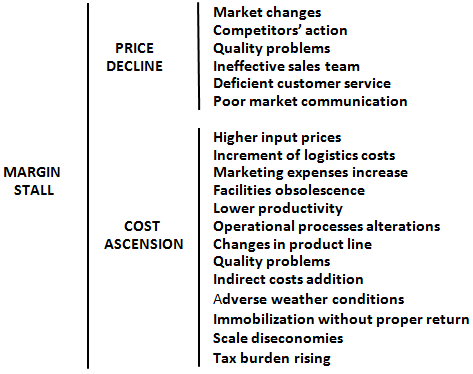Margin stall is the loss in sustaining the profitability margin of a sale object. This expression derives from the word stall used in aviation and aerodynamics to indicate loss of aerial sustain capacity by a moving object.
The margin stall phenomenon arises from the price drop or the cost ascension of the sale object without a change in the same direction and with the same intensity in its counterpart, be it price or cost.
In other words, for the margin not to collapse, its cost must be reduced by at least the same amount when the price of a sale object falls. On the other hand, when the cost grows, the sale price must also be increased by at least an identical value. If these movements do not happen, the margin stall will occur in both cases.
According to Michael Porter, this loss of support is due to the offerer’s deficiencies in generating and maintaining the value of its offers, the erosion of its competitive advantage caused by its competitors’ actions, and the evolution in the industry to which it belongs.
From the pricing perspective, the main reasons for the sale object price decline are: (a) changes occurred in the buyer or consumer market, (b) competitors’ actions, (c) quality problems of the product or service offered, (d) inefficient sales team, (e) failures in customer service, and (f) poor market communication.
Among the causes for the ascension of the supply cost are: (a) high input prices, (b) increased logistics costs, (c) raised marketing costs, (d) facilities obsolescence, (e) a drop in productivity, (f) significant changes in operating procedures, (g) changes in the product line, (h) offer quality problems, (i) increased indirect costs, (j) investments without due return, (k) diseconomies of scale, and (l) additional tax burdens, as exposes the summary below.

Although these reasons are well known, many managers need help to overcome them. This difficulty is caused not only by an insistence on ways of doing things that were successful in the past and are outdated but also by a deficiency of expertise in leading in-depth changes, a lack of accuracy of the offerer’s market, and fear of failure.
C. L. Eckhard, author of Pricing in Agribusiness: setting and managing prices for better sales margins.











 Claudio Luiz Eckhard is a former professor, business consultant, and author of the books “Ajustando o Rumo”[Adjusting the Business Course], “Gestão pela Margem”[Management by Margin], “A Empresa Saudável”[The Healthy Company], and “Pricing no Agribusiness”[Pricing in Agribusiness].
Claudio Luiz Eckhard is a former professor, business consultant, and author of the books “Ajustando o Rumo”[Adjusting the Business Course], “Gestão pela Margem”[Management by Margin], “A Empresa Saudável”[The Healthy Company], and “Pricing no Agribusiness”[Pricing in Agribusiness].


